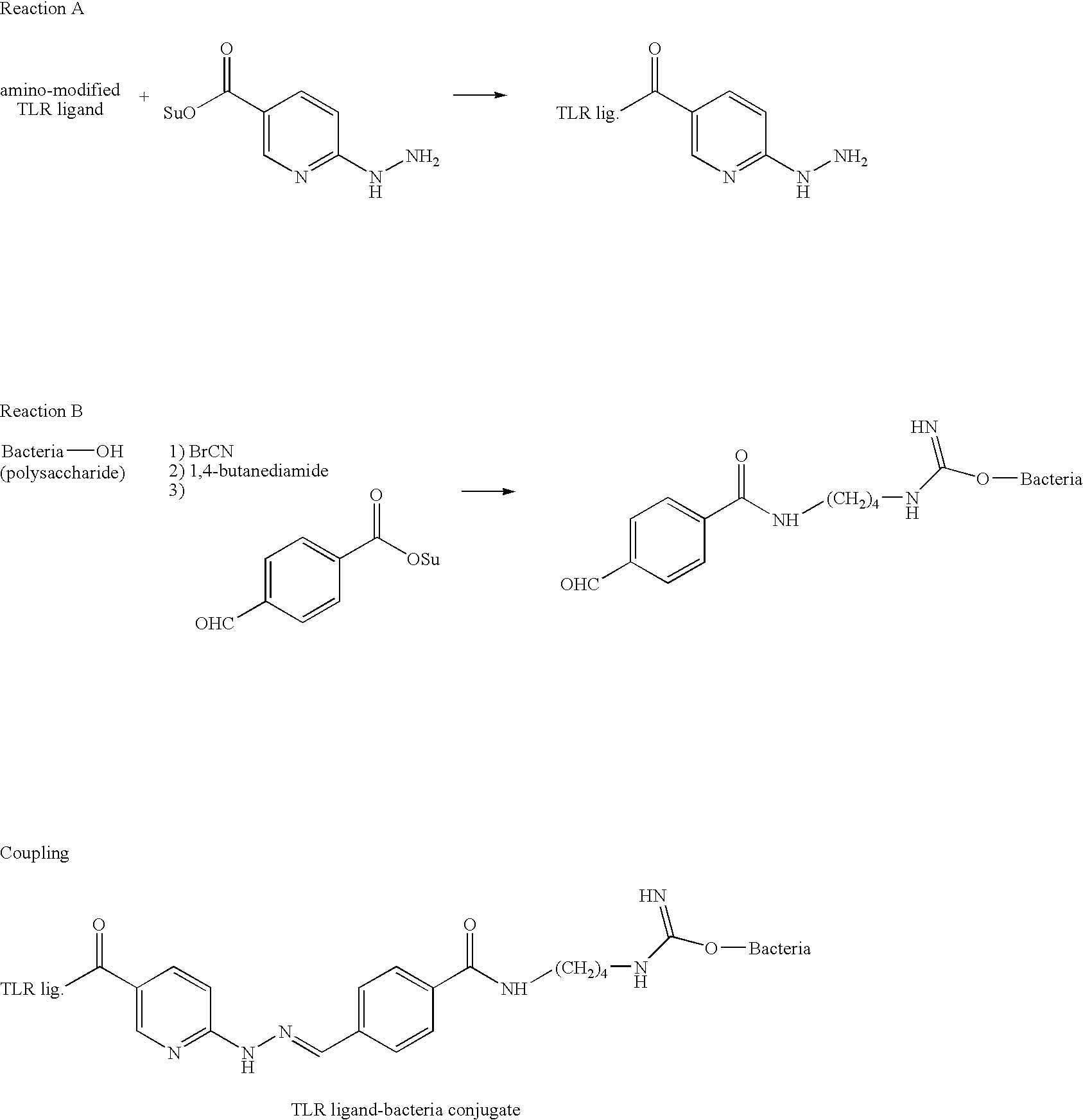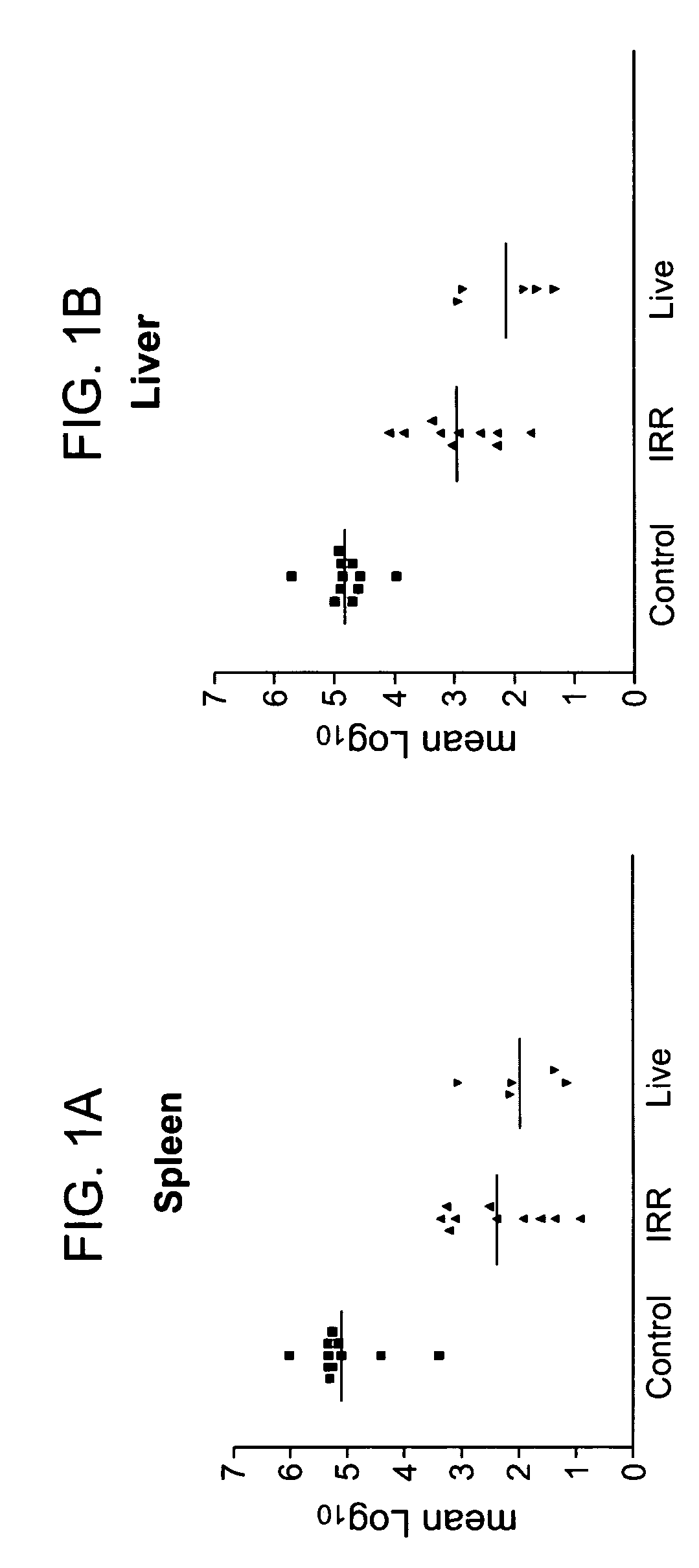Immunogenic compositions and methods of use thereof
a technology of immunomodulatory compositions and compositions, applied in the field of immunomodulatory compositions, can solve the problems of slow development of effective subunit vaccines, difficult to achieve, and high cos
- Summary
- Abstract
- Description
- Claims
- Application Information
AI Technical Summary
Problems solved by technology
Method used
Image
Examples
example 1
Comparative Efficacy of γ-Irradiated and Heat-Killed Listeria monocytogenes Vaccines
[0316] In general, killed bacterial vaccines have not been protective against intra-cellular bacterial pathogens such as M. tuberculosis and Listeria monocytogenes, whereas live vaccines are protective. The possibility that the usual methods of bacterial inactivation, such as heating or formalin fixation, may have been the problem, was considered, based on early experiments showing that irradiated, but not boiled, Lactobacilli retained TLR9 stimulating capability. Irradiated bacteria were tested as a vaccine in two standard mouse models of infection. Listeria monocytogenes, strain 1043 s (L.m.), was used. The bacteria were grown in trypticase soy broth (TSB) overnight, washed three times and resuspended in saline. The suspension was divided and some were γ-irradiated using a cesium (Cs) source for 3 hours; and the remainder were heat killed (HK) using heat treatment at 70.5° C. for 1 hour. It was co...
example 2
Comparative Efficacy of γ-Irradiated and Heat-Killed Salmonella dublin Vaccines
[0317]FIGS. 1A and 1B. To determine whether the effect of y-irradiation extended to gram-negative bacteria, infection of mice with Salmonella dublin was studied. As the live vaccine strain, LD842, an isogenic strain from which the virulence plasmid has been removed, was used. LD842 was compared to LD842 that was y-irradiated. In order to kill 100% of the Salmonella, the duration of the irradiation was increased to 18 hours (1.2 mR). Again, Balb / c.D2 (Nramp1 congenic) mice were immunized with two injections of γ-irradiated bacteria subcutaneously one week apart. These mice are genetically resistant to Salmonella infections because they do not have the mutant Nramp1 gene. (Normal people and non-inbred mice have wild-type Nrmp1 genes.) Mice were challenged with 1.2×103 live S. dublin two weeks after the last immunization. Mice were sacrificed 5 days after challenge; and the number of bacteria in spleen and ...
example 3
Comparative Efficacy of γ-Irradiated and Heat-Killed Listeria monocytogenes Vaccines
[0318]FIG. 2. Listeria monocytogenes (LM) 10403 S were cultured overnight at 37° C. in tryptic soy broth (TSB) and then resuspended in saline. An aliquot of this suspension was plated on tryptic soy agar (TSA) to determine the concentration of bacteria. Remaining aliquots of the bacterial suspension were then γ-irradiated, using a JL Sheperd Mark I Model 30 irradiator, with 600 Krad over six hours to prepare irradiated LM (IRL), or heated to 70° C. for one hour-to prepare heat-killed LM (HKL). The sterility of the IRL and HKL preparations was verified by lack of growth after incubating the equivalent of 109 colony forming units (CFU) in TSB and TSA for 48 hours at 37° C. C57B1 / 6 mice were then left untreated (“none”); immunized intraperitoneally with live LM (104 bacteria / mouse) on day 0 (“live”); or immunized subcutaneously at the tail base with HKL or IRL (109 bacteria / mouse) on day 0 and day 7 (“...
PUM
| Property | Measurement | Unit |
|---|---|---|
| Concentration | aaaaa | aaaaa |
| Solubility (mass) | aaaaa | aaaaa |
| Immunogenicity | aaaaa | aaaaa |
Abstract
Description
Claims
Application Information
 Login to View More
Login to View More - R&D
- Intellectual Property
- Life Sciences
- Materials
- Tech Scout
- Unparalleled Data Quality
- Higher Quality Content
- 60% Fewer Hallucinations
Browse by: Latest US Patents, China's latest patents, Technical Efficacy Thesaurus, Application Domain, Technology Topic, Popular Technical Reports.
© 2025 PatSnap. All rights reserved.Legal|Privacy policy|Modern Slavery Act Transparency Statement|Sitemap|About US| Contact US: help@patsnap.com



